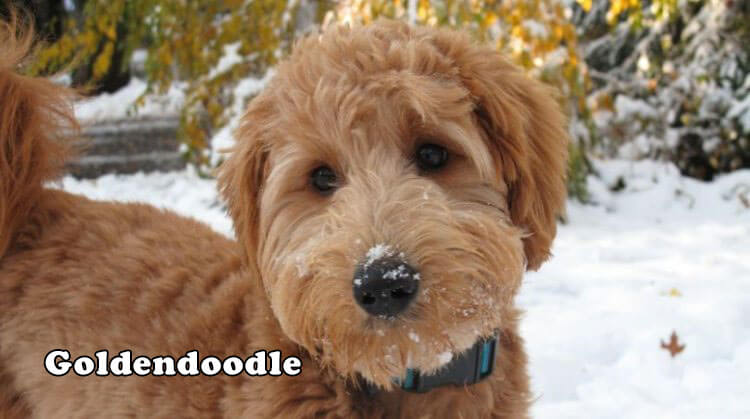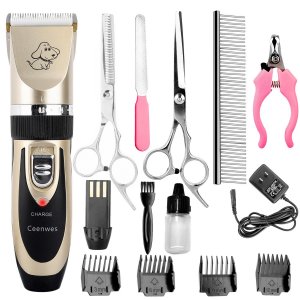Goldendoodle is a designer dog cross between Golden Retrievers and Poodle.
Like both of his parent breeds, he’s intelligent, friendly, and at least moderately active. Goldendoodles are outgoing, social dogs and often have an uncanny ability to communicate with their people.
They are popular in agility and obedience competitions because of their ancestry and their golden, curly fur.
Goldendoodle content overview
- History
- Different names
- Appearance and Characteristics
- Personality and Temperament
- Health & problems
- How to take care
- Puppy Information
- Puppy price
- Things to consider adopting a puppy
- Advantages & Disadvantages
- Photo gallery
History of Goldendoodle
The Goldendoodle is a crossbreed. It’s also known as Groodle, Goldendoodle, Goldenpoo, etc.
Monica Dickens first bred the Goldendoodle in 1969. It has become popular over the past ten or twenty years as people seek out dogs that are different from the everyday Yorkie or Poodle. The name “Goldendoodle” was first used in the United States in the early 1990s.
The original goldendoodle was a cross between a poodle and a golden retriever. Goldendoodles were first developed as guide dogs in 1969, but in the 1990s, the breed gained popularity among breeders.
This “designer mix” was bred to combine the poodle’s non-shedding coat with the golden retriever’s desirable temperament.
The creation of the Labrador Retriever and its popularity as a dog that is compatible with many people who have mild dog allergies undoubtedly sparked the concept.
Those who admired the Golden Retriever’s temperament but detested the amount of hair that was left behind or the allergy issues it caused were drawn to the stunning coats that shed little to no hair.
As a result, the goldendoodle became a worldwide hit! Breeders responded to requests for various sizes as the breed continued to develop.
The original purpose of the cross was to develop guide dogs suitable for visually impaired individuals with allergies. Goldendoodles are not recognized as a distinct breed by AKC, UKC, CKC, or any other widely-recognized all-breed purebred dog registry.
Let’s know about Golden Retriever and Poodle Dog breed.
Golden Retriever
The Golden Retriever is a large-sized breed of dog bred as gun dogs Origin from Scotland. The Golden Retriever, also known as the Golden, is one of the most loving and beloved canine breeds. The breed is a prominent participant in conformation shows for purebred dogs. The Golden Retriever is popular as a disability assistance dog, such as being a guide dog for the blind and a hearing dog for the deaf.
- Weight: Male 65–75 lb (29–34 kg), Female 55–65 lb (25–29 kg)
- Height: Male 22–24 in (56–61 cm), Female 20-22 in (51-56 cm)
- Lifespan: Average 10-12 years
Poodle
A poodle is a group of formal dog breeds. The origins of the poodles are still discussed with a dispute over whether the poodle descends from the old French Barbet breed or Germany as a water dog type. The poodle has been bred in at least three sizes, including Standard, Miniature, and Toy.
Different names or Types
All names
- Groodle
- Curly Golden
- Curly Retriever
- Goldenoodle
- Goldenpoo
Recognition
- American Canine Hybrid Club – ACHC
- Designer Dogs Kennel Club – DDKC
- Dog Registry of America, Inc – DRA
- Designer Breed Registry – DBR
- Goldendoodle Association of North America – GANA
- Goldendoodle Registry – TGR
- International Designer Canine Registry – IDCR
Appearance & Characteristics
A Goldendoodle’s overall look is a well-balanced, athletic, nicely muscled dog, whether small, medium, or larger, bearing in mind that a puppy’s size would depend on their parents. They have large, round, and very expressive eyes surrounded by hair which forms charming eyebrows.
Breed basic characteristics
| Origin | Canada/U.S.A |
| Scientific name | Canis lupus Familiaris |
| Group | None |
| Size: | Small to Medium |
| Lifespan: | 10 to 15 years |
| Trainability: | Easy Training |
| Exercise Needs: | Requires a moderate amount of exercise. |
| Grooming: | High Maintenance |
| Barking: | Frequent |
| Shedding: | Moderate Shedding |
| Protective Ability: | Good with Kids |
| Brushing: | Brushed regularly |
| Hypoallergenic Breed: | Yes |
| Space Requirements: | Apartment Friendly |
| Compatibility With Other Pets: | Good |
| Average Puppy Price: | Average $600 – $800 USD |
| Height | 13 to 24 inches |
| Weight | Miniature: 15-30 pounds (7-14 kg) Medium: 30-45 pounds (14-20 kg) Standard: 45-100 pounds (20-45 kg) |
| Litter size | 3-8 puppies |
Sound Behavior
Goldendoodles are a good choice for first-time owners because they are such clever characters like nothing more than, please.
Size
Size: There is three main sizes of Goldendoodle.
1). Standard Goldendoodle generally be 50 lbs. and up, and around 23 to 29 inches at the shoulder. Most standards are in the 70 to 90 lb. range.
2). Tiny Goldendoodle ranges from 10 to 24 lbs. They are about 12 to 17 inches at the shoulder.
3). Mini Goldendoodles generally range from 25 to 49 lbs. and are 18 to 22 inches at the shoulder.
Head
The head is round shaped medium in size and the eyes are almond shaped.
Skull: Foreface deep and wide, nearly as long as the skull.
Muzzle: The Goldendoodle has a straight, not dished, or downfaced, muzzle. The width is comparable to that of a Golden Retriever, though it is not as narrow as that of a Poodle. It is slightly wider at the stop than where the nose begins at the muzzle’s tip. The hair on their muzzles is long enough to form whiskers.
Eyes: Set in the shape of an oval, moderately wide, and do not protrude. There are no humps in the eyelids. Eyes are most often brown but on rare occasions can be blue or green. It has dark and oval-shaped eyes.
Ears: The front edges of the ears hang close to the cheek and are attached well behind, roughly aligned with the eye. The length of the ear reaches just below the lower jawline, and the leather is moderately thick. The hound’s low-set or low-hanging ears are not desirable. Ears are set high and moderately flat, dropping down close to the side of a dog’s head is covered in tight or loose curls.
Lip area: The lower jawline should be covered by the upper lip, but lips should never flutter or be pendulous. The upper lip curves down towards the throat as it disappears. In order not to appear snippy, the length of the underjaw should never be too short.
Teeth: The best teeth have full dentition and are strong and clean.
Bite: You need to bite with a scissor. Breeding a dog with malocclusion is not recommended.
Nose: Any colour or combination can be used. Breeding split-nosed dogs is not allowed.
Gait: A brisk, fluid gait that uses little energy. Similar to endurance trotters, they have strong reach and drive.
Neck, Topline, Body
Neck: Medium long, sloping well back into shoulders, giving sturdy, muscular appearance with an untrimmed natural ruff.
Topline: Generally level, with a small dip behind the withers and a small rise above the loins. The back never angles up or slopes off.
Body: Well balanced, short coupled, deep through the heart. The shape of the chest and ribs is elliptical. The brisket is pretty much as profound as the elbow when seen from the side. There is a sufficient tuck-in at the loin, but it is not excessive enough to make it look waspy.
Feet: Feet that are between a small and a medium size in relation to the dog’s size. Oval in shape, the foot is small, well-knuckled, and has cushion toes; pads are hefty. To keep nails from touching the ground, they are trimmed. Dewclaws are not required. Splayed or turned in or out feet are never present. Toes should never be too short or too high.
Tail: Set the tail a little bit high on the croup, but not so high that it makes a flat backline. The feathering on the tail should be seen.
Forequarters
When viewed from the front, they have straight legs and elbows that are tucked in close to the ribcage. Toes point forward. Pasterns are short and strong, and their forward angle is slightly sloping. To create a sense of balance, the shoulder blades are well positioned at an angle that matches the angle of the rear.
When standing four-square, the elbows are positioned back beneath the upper tip of the shoulder blades, and the upper arms and shoulder blades are approximately the same length. The ground is nearly level with each of the four legs.
Hindquarters
The croup has a slight slope ranging from 20 to 30 degrees, and the rear is heavily muscled. A dog that is balanced has a femur that joins the pelvis at an angle that is the same as the angle of the shoulder.
When standing foursquare, the rear pasterns are strong and perpendicular to the ground, the hocks are well let down, and the shoulders are well bent. When viewed from the rear, the legs are never cow-hocked, sickled, or bowed.
Coat
Goldendoodles are medium-sized dogs with extremely soft, wavy-to-curly coats that typically hang in loose ringlets everywhere on their bodies.
Goldendoodles can have different types of fur. Some look like shaggy retrievers; others resemble a Poodle with loose curls, and some fall somewhere in the middle.
The coats of goldendoodles can be straight or curly, depending on the breed. A brief description of the various types of coats you might encounter is as follows:
1. Straight Goldendoodle Coat
The straight goldendoodle is the least common type of coat, and it is frequently found in dogs with an improper coat. When compared to coats that are wavy or curly, these coats shed less and require less grooming. Even though these dogs don’t look like typical goldendoodles, they are still absolutely adorable and make great companions.
2. Wavy Goldendoodle Coat
The coats of the wavy goldendoodle are a perfect blend of the coats of the poodle and the golden retriever. This type of coat is the most prevalent among Goldendoodles and frequently sheds a little. To keep their gorgeous appearance and to prevent matting, wavy coats require regular brushing and grooming.
3. Curly goldendoodle coat
Curly Goldendoodle coats are the most hypoallergenic of all coat types and resemble the coat of the poodle. Although they shed little, these coats need to be groomed on a regular basis to keep them looking their best. Due to the fact that their coats produce less dander, curly Goldendoodles are an excellent choice for allergy sufferers.
4. Mixed Goldendoodle Coat
Coats of mixed Goldendoodles can have straight, wavy, and curly hair. Even within the same litter, this type of coat can vary greatly, so regular grooming is necessary to keep it looking its best.
Coat Color and Markings
The Coat Colors of the Goldendoodles are white, apricot, red, gold and cream. Goldendoodles’ coat color may be a light sandy brown or black sometimes.
Gait: When trotting, Gait is free, smooth, powerful, and well-coordinated.
Goldendoodle Coat Stages
Stages of the Goldendoodle Coat From puppyhood to adulthood, goldendoodle coats go through several stages. Throughout their development, their coat may change in texture, colour, and thickness. Understanding these changes and adapting your grooming routine accordingly is essential.
Goldendoodles typically have a soft, fluffy coat when they are puppies. Their adult coat, which may be wavy or curlier than their puppy coat, will begin to grow as they get older. This transition typically occurs between the ages of 5 and 12 months, but it can occur at any time.
The adult coat is typically denser and may necessitate more frequent grooming to avoid tangles and mats. Additionally, as they mature, some Goldendoodles may develop a new coat colour.
For example, a goldendoodle with a light puppy coat may grow darker hair as they get older, while others may develop a lighter coat over time. These modifications are unavoidable and enhance the individuality of each Goldendoodle.
Personality and Temperament
Personality
Goldendoodles have also become increasingly used as domestic pets due to their affection towards families and their friendliness and patience with children and strangers. Temperament is affected by several factors, including heredity, training, and socialization. Puppies with nice temperaments are curious and playful, willing to approach people and be held by them if you are interested in getting a puppy. Hence, Goldendoodle has a great personality dog.
Temperament
Goldendoodles are highly intelligent and energetic dogs, having inherited many of their parent breed’s traits both in looks and personality, which includes the fact they are highly intelligent, extremely affectionate while also being patient and gentle. They may be easy to train, patient, and kind with children. The Goldendoodles, although active dogs having a requirement of exercises but are also easy-going and calm dogs.
Activity Requirements
Goldendoodles are powerful and vigorous dogs and like to play hard work and play the game, especially the swimming. They are best suited to active families who will play games such as flyball and fetch. Goldendoodles are companion dogs. They love being with people and need to live in the house, never outdoors.
Behavioral Traits
Goldendoodle will become bored and lonely and may become depressed and destructive. Goldendoodle may have great family dog qualities and can be known as an excellent child-friendly dog. The Goldendoodle is a perfect choice for someone who wants a mid-sized, fluffy, cheerful canine companion that is not too high-maintenance but still is energetic enough to share an active lifestyle.
Trainability
Goldendoodles have a moderate activity level. Larger Goldendoodles may be more active than their smaller kin. They are intelligent and enjoy training, although they are sensitive to tone. Therefore clear positive instructions get the best results, accompanied by lots of praise and a few yummy rewards.
Health & problems
Health
The average lifespan of a Goldendoodle is 10 to 14 years. They probably are predisposed to the same diseases as the Golden Retriever and Standard Poodle. Goldendoodles should be kept active and trim for as long as possible to promote joint and heart health and long, happy life.
Health Problems
Now, mixed-breed dogs can inherit most of those diseases, too. But fortunately, the risk is lower in mixed breeds than in purebreds. Goldendoodles are generally healthy, but like all crossbreeds, they’re prone to certain health conditions. They include hip dysplasia skin disease called sebaceous adenitis, a heart condition called sub valvular aortic stenosis, Addison’s disease and eye diseases such as progressive retinal atrophy, cataracts, and glaucoma.
Feeding Plan
Puppies, just like human babies, are growing rapidly. Their muscles, organs, and bones are forever taking shape, and as such, they need extra nutrients in other to fuel this rapid growth. A proper and healthy diet is a must to keep your puppy healthy. It is very important for a puppy’s health and development. Goldendoodles have been known to suffer from bloat, and they need to be fed twice a day instead of giving a dog just one larger meal a day.
The Goldendoodle requires a healthy diet to stay away from any diseases.
- Normally puppies should be given food twice a day. There are varieties of puppy food available in the market, and you can buy the best as per your liking and budget.
- Goldendoodle pups between 8 and 12 weeks old need four meals in a day.
- 3 to 6 months old Pup Welsh Terrier needs soft food, especially milk, until 6 weeks.
- Goldendoodle puppy 3 times a day between 8 to 12 weeks.
- Feed puppies 6 months to 1 year two times every twenty-four hours.
- By the time your Goldendoodle hits her first birthday, 1 meal every 24 hours is usually sufficient.
Apart from giving them two and a half to three cups of dry dog food, Goldendoodle can also be passed a fish diet to help retain the oil in their skin. A special liquid diet is needed for those without middle teeth.
Living conditions
They can live in the city or on a farm. They are social dogs, and they are happiest when they are with people. Not suitable for small apartments or outdoor living. They will greet friends with affection and their family with steadfast loyalty.
How to take care?
Exercise
The Goldendoodle has an average energy level and will require daily exercise through walks or a good romp in the backyard. Generally speaking, 20 to 30 minutes of daily exercise. Goldendoodles are very social by nature, and even though they have working and hunting dogs in their lineage, they do not have a very high prey drive.
Goldendoodle puppies should not be over-exercised because their joints and bones are still growing. It includes not letting a dog jump up and down from furniture or going up or down the stairs.
Grooming & Bruising
Grooming is an essential activity for any breed of dog. Special care must be taken. Grooming isn’t only about taking care of the coat; it is the dog’s overall well-being. Grooming also mean taking care of dogs complete body to ensure that their ears and paws are clean. Trim their nails when required.
The Goldendoodle is considered a “brush & run” breed of dog. That means that grooming the Goldendoodle is not a difficult or time-consuming task. Give the coat a brush each day, clip nails once a month, and brush his/her teeth once a week.
You can use following Equipment for best grooming
Dogs require a lot of expertise as well as a wide range of equipment in grooming. Here is a list of best grooming equipment for Goldendoodle.
Ceenwes grooming kit
Here is a best and perfect Grooming kit for your Goldendoodle.
These dog grooming clippers also come with 11 tools: 1 × Pet clipper 1 × AC Power Adapter,1 × Cleaning Brush,4 × Comb Attachments 1 × Stainless Steel Scissor,1 ×Stainless teeth scissor,1 × Stainless Steel Comb,1 × Nail Clipper Kit,1 × Nail File,1 × Oil.
Table for Goldendoodle
One of the most critical items for groomers is their table. On this day, there are many tables available in the market like Electric Grooming Tables, Hydraulic Grooming Tables, Portable Grooming Tables so that you can choose any for your lovely dog. Find the best grooming table
Glove
The five fingers Deshedding Gloves do well in removing & trapping loose furry pet hair, minimizing the flying fur in your house, and keeping your home clean and pets healthy. Pet Gloves are made of skin-friendly materials, and the surface is soft silicone, which can give you love to pet a comfortable massage and not hurt the skin. The back is made of durable and breathable mesh that it’s very pleasing to use the Glove. The Glove is the best grooming equipment for any dog or pet. Buy Now Glove for low price
Dental Health Check-up
Dental health check-up is an important part of the tack care of dogs or pet. It should be something your dog comes to expect each day. If there is an infection in the mouth, it can allow bacteria into the body via the bloodstream and cause infections elsewhere. Kidney, heart, lung, and liver infections can all be caused by poor oral health. Bad teeth can, therefore, just be the ‘tip of the iceberg’. Most experts agree that daily brushing is ideal, but if that’s unrealistic, aim for three to four times per week.
Love & affection
Love and affection are useful for every dog. Suppose you give love and affection to your Goldendoodle, then the dog will love you back. Your Goldendoodle puppy will be a member of your family, So Give lots of love and affection to your cute puppy. Most importantly, spend time with your dog because that your dog needs love and affection.
Feed Healthy food
Feeding a healthy meal in the dog’s life is the most important. On this day, many healthy foods are available on the market so that you can choose any healthy food for your dog. Healthy food is the most important for dog health care. The young Goldendoodle is not a hearty eater as most breeds his size. He must often encourage meat juices or bacon grease mix in the food to entice him to eat.
The following items should never be fed to Goldendoodle dog:
- Alcohol, beer, wine or liquor
- Chocolate, coffee, or tea
- Grapes or raisins
- Moldy or spoiled food of any kind
- Onions, chives, and garlic
- Poultry bones
- Salt & salty foods
- Tomato leaves stems or unripe fruit
- Yeast dough
Insurance for Goldendoodles
Pet insurance for Goldendoodles costs more than for mixed breed dogs. Goldendoodles are more likely than mixed breed dogs to make claims for hereditary conditions that are expensive to treat.
Embrace pet insurance plans offer full coverage for all breed-specific conditions to which Goldendoodles are susceptible.
Puppy information
Goldendoodle puppies are adorable, and it’s one of the reasons they are so popular. Cute puppies sell, and that makes the Goldendoodle a favorite for puppy mills and greedy, irresponsible breeders. These young pups can chew up your furniture, demolish your favorite slippers and leave excessive amounts of excrement everywhere! Goldendoodles should be watched carefully and should be placed in a crate or other safe and secure area when unattended.
Puppy Training
These dogs love learning new things and a great way of starting their training and socialization is to enroll them into puppy classes where they get to meet lots of other dogs and people while at the same time being put through their paces in a safe and controlled environment. Goldendoodles are highly adaptable dogs providing they are given enough daily physical exercise combined with as much mental stimulation to prevent boredom from setting in.
Goldendoodles are smart dogs, having inherited their intelligence from both parent breeds. They also love to please and enjoy the one-to-one attention they get when they are being trained.
Crate training useful for every dog breed
Crate training your dog may take some time and effort but can be useful in various situations. First of all, understand that crate training is not cruel. Despite what some people may have told you, breeders and veterinarians recommend using a crate for your dog from a young age. A Crate can be invaluable while you are potty-training or teaching your dog the rules of the house; it’s a great way to transport your four-legged friend.
Obedience training
This training is one of the basic and most important pieces of training for any crossbreed. We use 3 methods of training with your Goldendoodle, all beginning with a strong foundation in the core 5 obedience commands: come, sit, stay, heel, down. Every dog should know these 5 basic obedience commands Because it is very necessary for obedience training.
Behavioral training
Behavioral training is very important for any dog. All of us, dog owners, need to administer some dog behavior training at some point in time. Behavioral training is very helpful for taking care of the dog. If you want to train your puppy to Behavioral training, find out some common behavioral issues like breaking, aggression, food guarding, howling, mouthing and chewing, separation anxiety, etc., and stop these behavioral issues train your dog easily.
Puppy price
Average puppy price: $600 – $800 USD
Find a dog or puppy
To get a healthy puppy, never buy a puppy from an irresponsible breeder, puppy mill, or pet store. Look for a reputable breeder who tests her breeding dogs to make sure they’re free of genetic diseases that they might pass onto the puppies and that they have sound temperaments.
Goldendoodle puppies for sale
Finding the right Goldendoodle puppy can be dog-gone hard work. PuppyFind provides a convenient and efficient means of selecting and purchasing the perfect Goldendoodle puppy for sale from the comfort of your home, 24 hours a day, 7 days a week.
Find a breeder
GANA is an organization for Goldendoodle Enthusiasts, both Breeders and Pet Owners, to support responsible breeding and pet ownership.
Email: board@goldendoodleassociation.com
Things to consider adopting a Goldendoodle
If you consider a Goldendoodle Dog, make sure you can provide him a proper outlet for his natural energy and bright mind.
The Goldendoodle needs early socialization and training. Like any mixed breed, he can become timid if he’s not
properly socialized when young.
If you’re seriously considering adopting a Goldendoodle, you should know.
- Before you adopt a Goldendoodle, consider how much time your new family member will spend alone. Remember, a puppy requires constant attention.
- Goldendoodle puppies are super cute, but put; puppies can be adorable, relentless machines of destruction.
- Before you adopt a puppy, ask yourself if you can walk your dog several times throughout the day.
- You also have the advantage of knowing that your dog is physically able to “hold it” for several hours at a stretch.
- Ask anybody who has adopted an adult dog then adopts an adult dog.
- If you’re unsure whether the new dog you’ve chosen is right for your family and lifestyle, consider fostering before committing.
Advantages of Goldendoodle
- Goldendoodles are a great choice for first-time dog owners
- Goldendoodles are Non or minimal shedders
- Affectionate, outgoing and loyal family pets
- Highly adaptable
- Great with children
- Highly intelligent
Disadvantages of Goldendoodle
- Need lots of exercises and mental stimulation
- Not the best watchdogs
- higher maintenance
Questions related to Goldendoodle
1. How is a Goldendoodle groomed?
Its nails must be trimmed, its teeth must be brushed, and its coat must be brushed every few days. Additionally, you can give them a variety of haircuts.
2. What does a Goldendoodle cost?
A goldendoodle can cost anywhere from $1,500 to $2,500. Their upkeep may also come at an additional cost of $2,000 per year.
3. How long does a Goldendoodle live?
A goldendoodle typically lives between 10 and 12 years.
4. Is a Goldendoodle suitable for children?
Golden doodles have a reputation for being patient and gentle with children. Additionally, they are extremely lively and playful with children of all ages.
5. What distinguishes F1 Goldendoodles from F1B Goldendoodles?
F1 goldendoodles have parents who are both poodle and golden retriever; F1B goldendoodles have parents who are both poodle and F1 goldendoodle; and F2 goldendoodles have only F1 goldendoodle parents.
Photo gallery
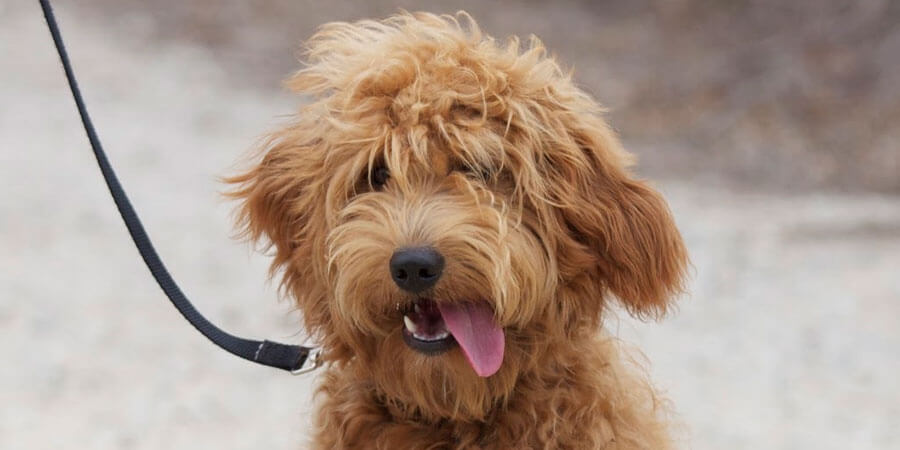

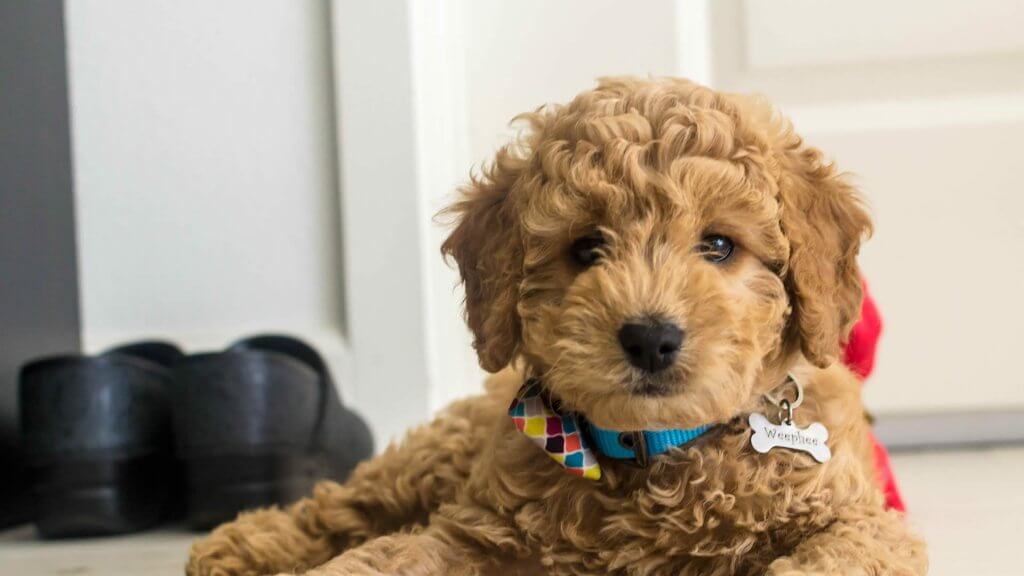
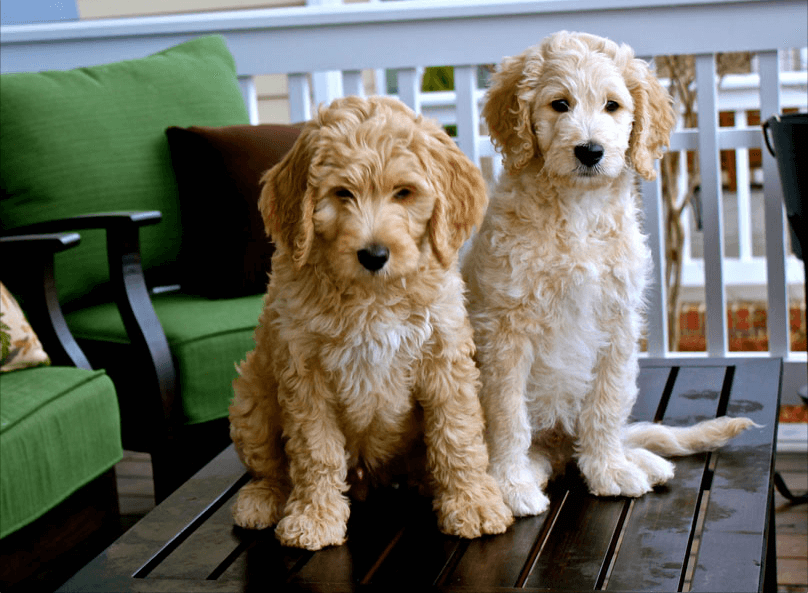
Got some questions? Or some suggestions? That’s why we’ve got a comments section on this blog! You can feel free to leave a comment or two down below, and we’ll get back to you as soon as possible!
We love reading your messages……
Also read: Top 10 benefits of having a Beagle
